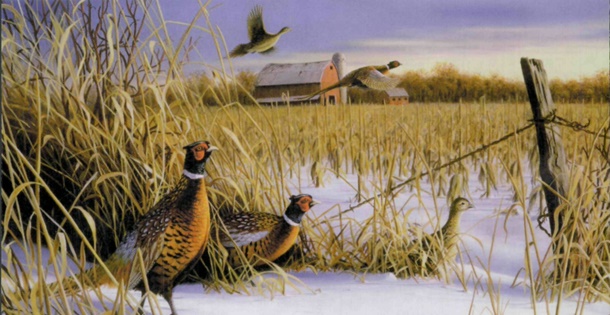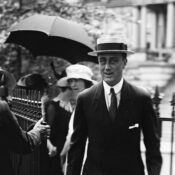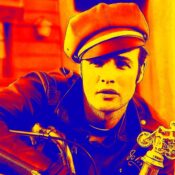Each fall in a selected U.S. city, a battle of the brushes heats up among America’s wildlife artists. The object of contention is a 11⁄4″ by 13⁄4″ perforated stamp issued yearly by the U.S. Fish and Wildlife Service as a receipt for a waterfowl hunting license. Hunters are required to purchase the stamps, but thousands of nonhunters line up to buy them as well, primarily to collect the gorgeous waterfowl images that decorate them. Since their introduction in 1934, duck stamps have captured the interest of conservationists, stamp collectors, and wildlife artists nationwide. The stamps have raised $700 million for wetlands conservation, improving the environment for ducks, geese, and other waterfowl, and probably for human beings as well. Winning the annual contest and having their art on the stamp is a dream of wildlife artists everywhere. Hundreds submit their paintings for judging every year. Among them, three brothers have made quite a name for themselves.
Joe, Bob, and Jim Hautman of Minnesota have put their own stamp on the hallowed history of the contest by collectively sweeping first place eight times in the last 18 years—a record for a single family. The brothers also regularly take top honors in state duck stamp contests, and their art has been exhibited at the Smithsonian and the White House. So successful have the brothers been at wowing contest judges that competitors find themselves looking over their shoulders whenever a Hautman entry is around. And that is almost always the case, because at least one or two Hautman brothers enter every Federal Duck Stamp contest.
The Hautmans’ prowess at winning is a hot topic in art chat rooms, where duck stamp competitors try to analyze the “secret ingredient” of their exceptional paintings. Called “The Hautman look,” one artist has described it as characterized by “strong contrasts, heavy darks, crisp detail, but not too much of it, and great-looking compositions when reduced.” Whatever it is, few deny that the brothers have justly earned their many wins. As one artist explained it, “the Hautmans are outrageously talented.”
Not surprisingly, the winning image on the 2008-2009, 75th-anniversary duck stamp (on left) is once again a Hautman original, this time a pair of pintail ducks relaxing among reeds and outlined against a gunmetal sky, painted by Joe Hautman, 52.
Joe, the oldest of the painting brothers, has a second profession he can fall back on should he ever tire of painting ducks. He holds a Ph.D. in theoretical physics. As a young man, he recalls being torn between his two favorite subjects, science and art. He chose science and decided to paint for fun. “I was painting on the side, and my brothers kept telling me I should enter the Federal Duck Stamp contest,” he says. “They had seen my work and thought I had a chance to do well.” And he did. On only his fifth attempt, he won the federal contest in 1992. Thinking that might be a fluke, he entered a state contest and won it, as well. That’s when he decided to trade his physics notebooks for a full-time palette and easel. “And I really haven’t regretted it at all,” he says.
The three brothers now live within thirty minutes of one another in the waterfowl-rich state where they grew up surrounded by hunters, wildlife, and artists. “Our mom was a professional commercial artist before she married,” Joe says, “and she used to invite her artist friends over to paint. Dad used to hunt, and he kept all his duck stamps. He wasn’t really a collector, but he just liked the images on them. He had a collection of all of them since the very first one in 1934. I think it is interesting because that’s part of the whole argument for having the pictorial duck stamp. It’s something that draws people into it. It’s not like having a number on your hunting license; it’s something that makes people think about ducks and want to learn more about them.”
None of the three brothers have formal art training, Joe says. Ironically, their older brother, Pete, did study to be an artist but turned to writing instead. He won The National Book Award for Young People’s Literature in 2004.
The brothers work in their separate home studios. Any similarities in their finished paintings, Joe says, is only in the mind of the beholder. “To me, it’s pretty easy to tell them apart,” he says. “They are very much reflections of our different personalities, maybe more in the way they are done than in how they look in the end. Jim is deliberate and methodical. He mixes up all the colors he wants beforehand, and he knows just what he’s going to do and puts the paint on in a very methodical way. He has a technique, which is a nice thing. Bob, on the other hand, is a much more free spirit. Maybe it sounds bad to say it, but he’s kind of chaotic. He just starts putting paint on the canvas. He may start out with a painting of a loon, and it will end up being a bear or something. You just never know where it’s going to go!”
So what is their winning ingredient? Part of it may be that they critique each others’ paintings, even though they are often competing. “I think that’s a huge part of our success, actually, Joe says. “Bob was just by yesterday with his entries for this year’s duck stamp contest. I’m not doing one, but he and Jim have both got one going, and Bob stopped by to get a critique. When you are doing a painting that you work on for so long, it’s really hard to maintain your perspective. You may send it in to a contest, and it comes back after you’ve lost, a few months later, and you go, ‘Oh, my, what did I do?’ Having that fresh look, if you can get it somehow, is a huge advantage—and it’s great to have somebody who knows the ducks and knows the contest and, most important, isn’t afraid to tell you what he thinks.”
When not concentrating on duck stamp paintings, the brothers produce a variety of wildlife art, usually of North American animals, such as elk, bear, and wolves. Some are so realistic, they appear almost like photographs. A recent work of Joe’s, however, has taken a different tack, a montage of fifteen different animals from India. “My wife is from India, and so we go there often,” he says. “I thought I had finished it. But I recently decided that the main animal I started with, which was a spotted deer, kind of never seemed right. So, I’m going to take that out and put a tiger in. That really makes it more of a kind of fantasy piece,” he says. “It’s a departure for me, but a direction it seems that it had to go.”
The Hautmans’ paintings sell in the four- to five-figure range. But if you want an original Hautman duck stamp painting, you may be disappointed. All of them have been purchased by one collector who displays them in his Florida home.
The brothers are duck hunters as well as painters, and Joe finds a connection between the two. “Part of hunting [as in painting] is a lot of observation,” he says. He spent two weeks painting this year’s winning picture. “But I spent a good number of weeks’ preparation before that working on designs,” he says. “I had five or six designs for a while and finally narrowed it down to a couple. When I finally decided which one I wanted to do, I worked on the drawing of that and doing some different color variations before I actually started painting, so it was a month or more to finish the whole thing.”
What made it stand out as a winner? “I wish I knew,” Hautman says. “Sometimes it’s just that way, that you get something and you don’t know what it is.”
Will a Hautman succeed again in the heat for the 2009-2010 federal duck stamp cover? By the time you read this article, the results of the October 2008 contest in Bloomington, Minnesota, will be known.
Become a Saturday Evening Post member and enjoy unlimited access. Subscribe now



